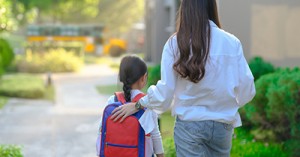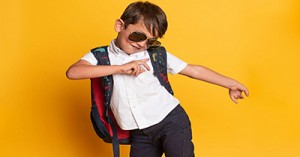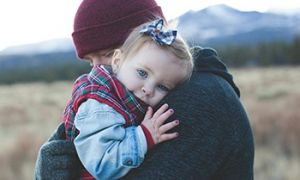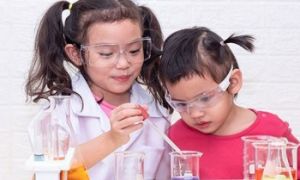A child’s Transition Statement summarises their abilities as they start school and identifies their individual approaches to learning. Though there might be several people contributing to the information included in the Transition Statement, early childhood educators have the primary responsibility of drawing up the Transition Statement. The following article provides information on the Features Of Transition Statements and Practical Examples For Each Learning Outcome.
Features of Transition Statements
The practical examples given below have the following common features:
- They use a strength-based approach; transition documents are supposed to communicate what children have learnt, can learn and how they can continue to be supported to learn.
- They are written clearly and succinctly – the number of words used on average is 120 and up to 170 for more complex issues.
- ‘Reader’ includes parents and school-based educators and if applicable, OSHC educators.
- The statement briefly presents the learning and development that has taken place, as well as the strategies that have been successfully used to support and extend the child’s learning and development.
- They are aligned to the five learning and development outcomes as reflected in the approved learning frameworks – national and state – along with inclusions, if any, to strengthen the information in the statement and provide the reader with insight into each child’s learning and development. However, the statement can also be placed against more than one outcome area.
Practical Examples For Learning Outcome 1 - Children Have A Strong Sense Of Identity
Example 1
David enjoys being in the company of his peers. He often engages in dramatic play and will act out various roles (e.g. mother, father) with two to three other children. When playing, he confidently expresses his ideas and asks other children for help. When faced with a new learning activity, David benefits from clear 1:1 instructions so he can focus. Once focus, he will persist with challenging tasks (e.g. fine motor-based activities), especially when given encouragement and praise.
This statement aligns with the following Learning Outcomes:
- has the skills required to include others and make friends with peers, teachers and other trusted adults.
- With support is able to persist when faced with most challenges and when first attempts are not successful
The statement tells the reader that David:
- Is social, expressive and enjoys dramatic play.
- requires 1:1 adult assistance to focus his learning. David responds well to praise and encouragement.
Example 2
Angus is highly communicative and frequently initiates conversations with adults/peers to express his ideas. He has developed close friendships with a wide range of children in the group and varies the children that he will play with from day to day. He lives with his grandmother (his primary caregiver), and does not have any siblings. He has strong relationships with his cousins (all of whom attend the school he will be starting at). He likes to bring various things from home to show others what his grandmother has made for him. Angus enjoys being part of large and small group activities and often shows care for others, e.g. making room for a peer next to him or helping a friend with a difficult task.
This statement aligns with the following Learning Outcomes:
- Has the skills required to include others and make friends with peers, teachers and other trusted adults.
- Is able to confidently share aspects of their culture with other children and educators.
The statement tells the reader:
- That Angus is communicative.
- That Angus has a range of close friendships and will vary who he plays with.
- What his living arrangements are.
- That Angus likes to share aspects of his culture with others
Example 3
Linh is beginning to understand her cultural background as a Vietnamese-Australian and understands that other children and families have different cultural backgrounds and languages. Over the year, Linh made pleasing progress with her ability to socialise and play with a range of children in her class. Initially, she only played with a small group of Vietnamese-speaking girls. However, by the end of the year she has shown confidence in playing with many of the children in the group.
The above statement aligns with the following Learning Outcomes:
- With support is able to include others and make friends with peers, teachers and other adults.
- Is able to confidently share aspects of their culture with other children and educators.
The statement tells the reader that Linh:
- recognises cultural differences
- has improved her language and communication skills
- has recently shown confidence in interacting with others
Practical Examples for Learning Outcome 2 - Children Are Connected With And Contribute To Their World
Example 1
Kobi is highly imaginative and will often engage one or two other children to tell them about his ideas. He particularly enjoys outside play when he has access to materials where he can make various constructions with his peers. He contributes ideas to overcome problems, saying for example, “no, that will be a bit too heavy”, and will accept others’ suggestions that are different from his own. When a child has been excluded by others, he will notice this and find ways to include the child in the group activity like, by handing them a shovel to dig with. He takes care of the natural environment whilst playing and has been observed walking between plants and only taking sticks that have fallen to the ground.
The above statement aligns with the following Learning Outcomes:
- Is able to cooperate with others and negotiate roles and relationships in familiar and new play episodes and group experiences.
- Often demonstrates an increasing knowledge of and respect for the natural world and constructed environments, including an increased understanding of the interdependence between, land, people, plants and animals.
The statement tells the reader that Kobi:
- contributes his ideas and identifies possible obstacles.
- accepts the suggestions/contributions of others.
- shows care for others and will take action to be inclusive
Example 2
Gemma is learning how to respond to others’ contributions and ideas in more positive ways. Dramatic play and puppet role-playing have been used with some success to help her understand the feelings and points of view of others. Gemma is able to recognise how others are feeling and with adult prompting/modelling, is able to respond empathetically, for example, by. getting a chair or tissue for a peer. Gemma’s ability to show care for the classroom environment has vastly improved but she still benefits from reminders to tidy up with the group.
The above statement aligns with the following Learning Outcomes:
- Is beginning to listen to others' (peers and adults) ideas and respect different ways of being and doing.
- Usually displays the ability to recognise fairness and bias and to demonstrate acts of compassion and kindness
The statement tells the reader that:
- Gemma has developed ways to positively respond to her peers.
- Her ability to help with tidying up has improved.
Example 3
The kindergarten and Sean’s family have focused on his social skill development and he continues to benefit from adult support to manage his interactions with other children. An egg timer has been used to help with turn taking and this has contributed to him beginning to develop friendships. His love of cars and vigorous play has been used to help him focus and this has led to an increase in his ability to respond positively to his peers, reducing his aggressive behaviours towards others. Sharing toys, play spaces and movement between activities can trigger aggressive behaviour (pushing, hitting). Giving Sean a responsible task and having an adult engage him in conversation about the task helps him to move into the next activity. With these strategies in place, a significant reduction in aggressive behaviour has been noted (i.e. one or two per month).
The above statement aligns with the following Learning Outcomes:
- Sometimes requires support to cooperate with others and negotiate roles and relationships in play episodes and group experiences.
- Requires adult prompts and guidance to recognise fairness and bias and to demonstrate acts of compassion and kindness.
The statement tells the reader that:
- Sean can act out physically towards others.
- Triggers for aggressive behaviours are identified.
- Integrating his love of cars and vigorous play will help him engage with the school curriculum.
- Sean’s family have been involved in supporting the development of his social skills.
Practical Examples For Learning Outcome 3 - Children Have A Strong Sense Of Wellbeing
Example 1
Mei is a quiet and reserved child. She settles best in the morning if given time to say goodbye to her mum and then by taking her hand and leading her to the mat for an activity. This usually takes about 10 minutes. Mei will respond to an adult positively if she is able to keep her special bunny with her, especially at the start of the day. I have discussed Mei’s difficulty with separation with her parents and they are happy with our approach to settling her. Throughout the day, Mei will join in activities and play alongside other children. She is beginning to initiate conversations with peers to share her interests.
The above statement aligns with the following Learning Outcomes:
- Requires some assistance to remain accessible to others at times of distress, confusion and frustration.
- Sometimes requires support to understand, self-regulate their behaviour and manage their emotions in ways that reflect the feelings and needs of others.
- Is increasingly cooperative and usually able to work collaboratively with others.
The statement tells the reader that:
- Mei needs objects like the bunny and routines like taking her hand to help with settling.
- Mei’s family are aware of her difficulty with separation and is supportive of the strategies used.
- She is beginning to share her interests and learning
Example 2
Sharon uses appropriate verbal communication most of the time. When initiating play with others, she will use physical actions such as firmly wrapping arms around her peers, pushing, hitting or taking items away from other children. Sharon wants to involve others in her active play and she is beginning to develop appropriate ways of having other children join her. I’ve worked with Sharon to model appropriate behaviour and to understand that other children want their own ‘personal time’ and that it’s ok. She will do well with being reminded gently to use words instead of physical actions and praised when she does.
The above statement aligns with the following Learning Outcomes
- Is increasingly cooperative and usually able to work collaboratively with others.
- Sometimes requires support to understand, self-regulate their behaviour and manage their emotions in ways that reflect the feelings and needs of others.
The statement tells the reader that Sharon:
- uses appropriate language most of the time.
- has difficulty understanding boundaries but responds well to adult-modelled behaviour.
Example 3
Andrew continues to need support to use the toilet. We have supported him by establishing a regular routine of reminding him every two hours. He will benefit from being introduced to and shown how to use the urinal and toilet blocks at school. He may need continued support in going to the toilet for undressing. He prefers privacy but feels comfortable knowing an adult is present nearby. If an accident occurs, Andrew may withdraw from a group or activity and cry. The best way to help him re-enter the group has been to take him to a private place to be changed. Reading him a quick story before he returns to the group to distract him from focusing on the accident also works well. Andrew has undergone a medical assessment (organised by his parents) with no medical conclusion determined.
The above statement aligns with the following Learning Outcomes
- Is developing independence and competence in regard to personal hygiene/toileting however requires support and prompts.
- Requires some assistance to remain accessible to others at times of distress, confusion and frustration
The statement tells the reader:
- What to do when toileting accidents happen – privacy, read a story before entering the group.
- That the routine of regular reminders supports Andrew to manage himself.
- That Andrew has been medically assessed but no medical conditions have been identified.
Practical Examples For Learning Outcome 4 - Children Are Confident And Involved Learners
Example 1
During the first half of the year, Mia has shown an excellent ability to manage time and resources to complete short tasks. She shows persistence when working on set tasks, the ability to take initiative as well as a strong interest in mathematics. For example, she is able to recognise numbers and represent them using objects e.g. “– makes four play dough cakes.
The above statement aligns with the following Learning Outcomes:
- Often displays curiosity and enthusiasm for learning.
- Often follows and extends their own interests with deep engagement and concentration.
- Is able to connect number names, numerals and quantities, including zero and beyond 10
The statement tells the reader that Mia:
- shows positive dispositions for learning: persistence and review, initiative and independence
- would be ready for extension of numeracy activities, like subsidisation; modelling addition and subtraction.
Example 2
Dominic is a ‘hands on’ learner, learning best from tactile, creative and concrete experiences. He has well-developed planning and problem- solving skills which is evident when he builds block constructions, collages and Lego projects. He is inquisitive, has a keen desire for knowledge and great ability to retain and recall information. At times, Dominic may be distracted by other children or his imaginings, particularly in large group situations, and he may find it hard to concentrate on instructions by an adult. Dominic responds well to visual signals such as lists, badges, signs, photos and auditory cues such as quiet gentle music.
The above statement aligns with the following Learning Outcomes:
- Is able to explore ideas and theories using imagination, creativity and play.
- Often displays curiosity and enthusiasm for learning.
- Currently requires adult prompts and encouragement to follow and extend their own interests with engagement and concentration
The statement tells the reader that Dominic:
- prefers a kinaesthetic learning style.
- displays learning dispositions such as: eagerness and curiosity.
- is effectively re-directed through the use of visual signs and music.
Practical Examples for Learning Outcome 5 - Children Are Effective Communicators
Example 1
Julia has an extensive expressive and receptive vocabulary and is using language to communicate complex ideas and thoughts. She also understands concepts about print and her parents have been providing a literacy-rich environment to extend her learning in this area.
The above statement aligns with the following Learning Outcomes:
- Successfully conveys and constructs messages, building on literacies of home and/or family.
- Has developed an awareness of the relationships between oral, visual and written representations and is beginning to recognise their patterns.
The statement tells the reader that Julia:
- has a large vocabulary and is ready to engage with literacy learning.
- has been supported by her parents in this area.
Example 2
Ruby has increased her spontaneous communication with adults and peers substantially during the course of the year. She has received monthly speech pathology support focussing on improving her articulation and she is now understood by familiar people. By using a range of non-verbal cues such as facial expressions and gestures, Ruby is more willing to help the listener to understand what she is saying. She is increasingly confident in initiating play with peers rather than continuing to follow the lead of others.
The above statement aligns with the following Learning Outcomes:
- Usually engages in enjoyable reciprocal interactions using verbal and non-verbal language with familiar peers/adults.
- Usually engages in conversations and discussions (using active listening, showing interest, and contributing ideas, information and questions, taking turns and recognising the contributions of others)
The statement tells the reader that Ruby:
- has received monthly speech pathology support.
- has made progress with her clarity of speech and social confidence.
- is persistent in helping others understand her.
Example 3
Cameron has been diagnosed with Down’s Syndrome and has received fortnightly support from a speech pathologist to develop his listening, attention and understanding as well as the use of verbal and non-verbal communication.
Cameron understands simple questions and short instructions, for example, “where’s the pig?” and benefits from the use of gestures, signs and pictures to aid his overall understanding. He uses a combination of single words and Makaton signs to make requests, and comments and to join in songs. He enjoys group song times very much and the use of puppets, props and musical instruments has helped to focus during group activities. This increased level of attention has helped him learn song words, actions, turn-taking and some keywords/ signs associated with his favourite songs like, ‘Old McDonald’.
A Makaton signing workshop attended by a kindergarten staff helped facilitate Cameron’s use and understanding of signs and verbal language The most useful/ relevant Makaton signs for Cameron have been collated by his parents and staff and are attached to this Transition Statement.
The above statement aligns with the following Learning Outcomes:
- Usually engages in enjoyable reciprocal interactions using verbal and non-verbal language with familiar peers/adults.
- Sometimes uses creative arts, such as drawing, painting, sculpture, drama, dance, movement, music or/and story-telling, to express ideas and make meaning.
The statement tells the reader that:
- Cameron best accesses learning through singing
- His participation in group activities increased through the use of props and musical instruments
- He communicates using single words and Makaton signs and is able to understand simple instructions and questions
- Staff training in Makaton signing would facilitate Cameron’s verbal communication
Further Reading
Transition To School Statements - The following article provides information on Writing Transition To School Statements, Reflecting On A Child's Learning and Development, Suggested Inclusions and more.
How Children Can Achieve EYLF Learning Outcomes - This provides examples of how children can achieve each individual EYLF Outcome through play and learning. The language used here can be included in Transition Statements, along with practical examples.
Descriptive Words For Documentation, Observations and Reports - The following is a list of descriptive words that can be used while writing.
Sentence Starters For Documentation Posters - Enable Educators to provide phrases to connect ideas more effectively when writing documentation. The following posters provide sentence starters for a range of different purposes.
Synonyms For Documentation Posters - The following posters list synonyms that can be used when writing documentation such as observations, learning stories, reports and more. Synonyms are words or phrases that mean the same as another word. Using these posters will enable you to broaden your vocabulary when writing.
Descriptive Words For Documentation Posters - A list of descriptive words that can be used while writing. These can be used as a reference point for Educators when completing documentation.
References:
Transition To School Resources Kit, Department Of Education, Victoria
QKLG Transition Statements, Department Of Education, Queensland







 Here is the list of the EYLF Learning Outcomes that you can use as a guide or reference for your documentation and planning. The EYLF
Here is the list of the EYLF Learning Outcomes that you can use as a guide or reference for your documentation and planning. The EYLF The EYLF is a guide which consists of Principles, Practices and 5 main Learning Outcomes along with each of their sub outcomes, based on identity,
The EYLF is a guide which consists of Principles, Practices and 5 main Learning Outcomes along with each of their sub outcomes, based on identity, This is a guide on How to Write a Learning Story. It provides information on What Is A Learning Story, Writing A Learning Story, Sample
This is a guide on How to Write a Learning Story. It provides information on What Is A Learning Story, Writing A Learning Story, Sample One of the most important types of documentation methods that educators needs to be familiar with are “observations”. Observations are crucial for all early childhood
One of the most important types of documentation methods that educators needs to be familiar with are “observations”. Observations are crucial for all early childhood To support children achieve learning outcomes from the EYLF Framework, the following list gives educators examples of how to promote children's learning in each individual
To support children achieve learning outcomes from the EYLF Framework, the following list gives educators examples of how to promote children's learning in each individual Reflective practice is learning from everyday situations and issues and concerns that arise which form part of our daily routine while working in an early
Reflective practice is learning from everyday situations and issues and concerns that arise which form part of our daily routine while working in an early Within Australia, Programming and Planning is reflected and supported by the Early Years Learning Framework. Educators within early childhood settings, use the EYLF to guide
Within Australia, Programming and Planning is reflected and supported by the Early Years Learning Framework. Educators within early childhood settings, use the EYLF to guide When observing children, it's important that we use a range of different observation methods from running records, learning stories to photographs and work samples. Using
When observing children, it's important that we use a range of different observation methods from running records, learning stories to photographs and work samples. Using This is a guide for educators on what to observe under each sub learning outcome from the EYLF Framework, when a child is engaged in
This is a guide for educators on what to observe under each sub learning outcome from the EYLF Framework, when a child is engaged in The Early Years Learning Framework describes the curriculum as “all the interactions, experiences, activities, routines and events, planned and unplanned, that occur in an environment
The Early Years Learning Framework describes the curriculum as “all the interactions, experiences, activities, routines and events, planned and unplanned, that occur in an environment


